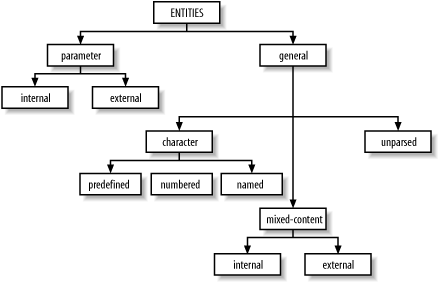Entities
Entities are placeholders in XML. You declare an entity in the document prolog or in a DTD, and you can refer to it many times in the document. Different types of entities have different uses. You can substitute characters that are difficult or impossible to type with character entities. You can pull in content that lives outside of your document with external entities. And rather than type the same thing over and over again, such as boilerplate text, you can instead define your own general entities.
Figure 2-17 shows the different kinds of entities and their roles. In the family tree of entity types, the two major branches are parameter entities and general entities. Parameter entities are used only in DTDs, so I’ll talk about them later, in Chapter 4. This section will focus on the other type, general entities.
 |
An entity consists of a name and a value. When an XML parser begins to process a document, it first reads a series of declarations, some of which define entities by associating a name with a value. The value is anything from a single character to a file of XML markup. As the parser scans the XML document, it encounters entity references, which are special markers derived from entity names. For each entity reference, the parser consults a table in memory for something with which to replace the marker. It replaces the entity reference with the ...
Get Learning XML, 2nd Edition now with the O’Reilly learning platform.
O’Reilly members experience books, live events, courses curated by job role, and more from O’Reilly and nearly 200 top publishers.

